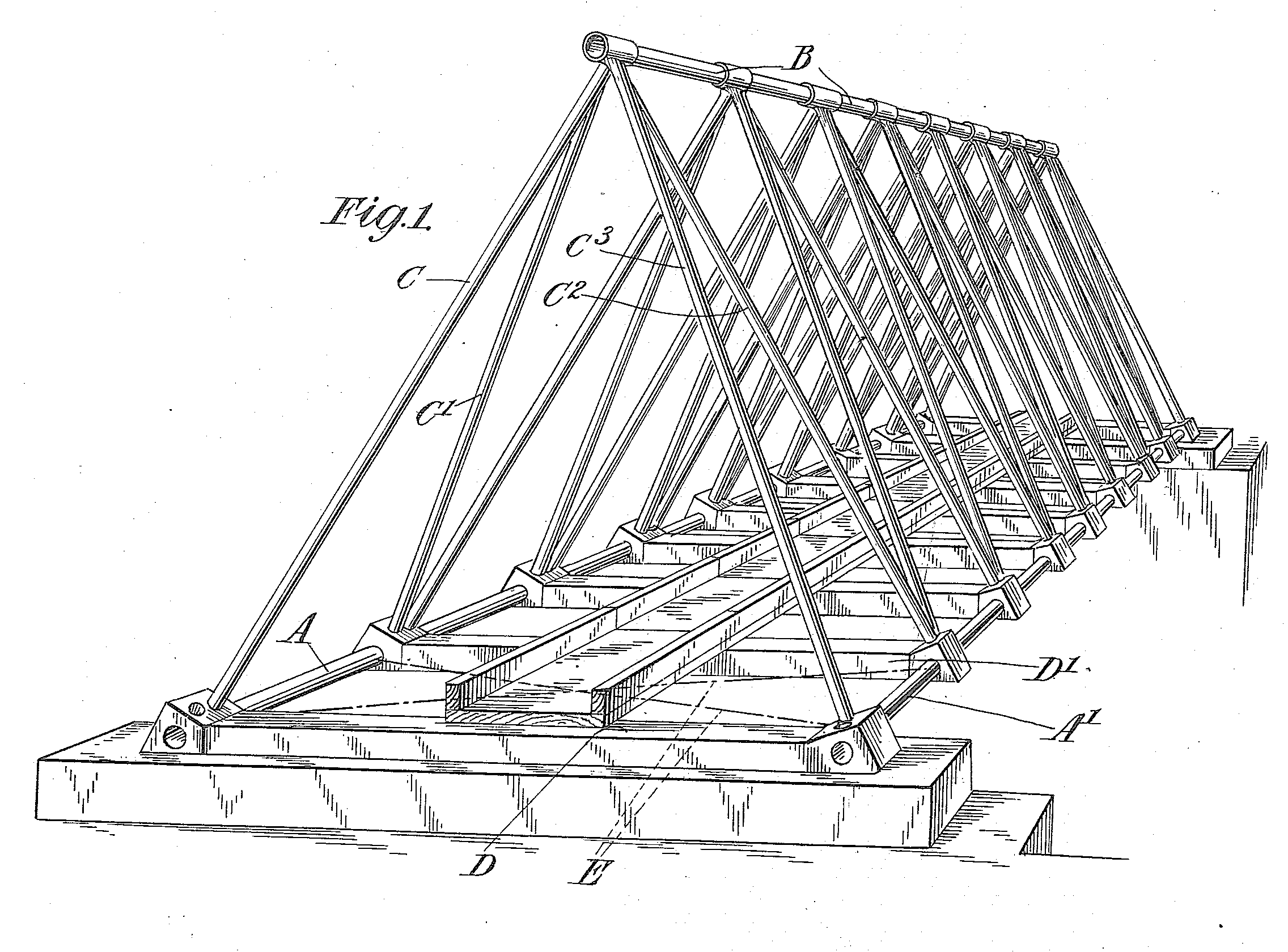|
Charles Inglis (engineer)
Sir Charles Edward Inglis, (; 31 July 1875 – 19 April 1952) was a British civil engineer. The son of a doctor, he was educated at Cheltenham College and won a scholarship to King's College, Cambridge, where he would later forge a career as an academic. Inglis spent a two-year period with the engineering firm run by John Wolfe-Barry before he returned to King's College as a lecturer. Working with Professors James Alfred Ewing and Bertram Hopkinson, he made several important studies into the effects of vibration on structures and defects on the strength of plate steel. Inglis served in the Royal Engineers during the First World War and invented the Inglis Bridge, a reusable steel bridging system – the precursor to the more famous Bailey bridge of the Second World War. In 1916 he was placed in charge of bridge design and supply at the War Office and, with Giffard Le Quesne Martel, pioneered the use of temporary bridges with tanks. Inglis retired from military s ... [...More Info...] [...Related Items...] OR: [Wikipedia] [Google] [Baidu] |
Worcester, England
Worcester ( ) is a cathedral city in Worcestershire, England, of which it is the county town. It is south-west of Birmingham, north-west of London, north of Gloucester and north-east of Hereford. The population was 103,872 in the 2021 Census. The River Severn flanks the western side of the city centre. It is overlooked by Worcester Cathedral. Worcester is the home of Royal Worcester, Royal Worcester Porcelain, composer Edward Elgar, Lea & Perrins, makers of traditional Worcestershire sauce, the University of Worcester, and ''Berrow's Worcester Journal'', claimed as the world's oldest newspaper. The Battle of Worcester in 1651 was the final battle of the English Civil War, during which Oliver Cromwell's New Model Army defeated Charles II of England, King Charles II's Cavalier, Royalists. History Early history The trade route past Worcester, later part of the Roman roads in Britain, Roman Ryknild Street, dates from Neolithic times. It commanded a ford crossing over the Rive ... [...More Info...] [...Related Items...] OR: [Wikipedia] [Google] [Baidu] |
James Alfred Ewing
Sir James Alfred Ewing MInstitCE (27 March 1855 − 7 January 1935) was a Scottish physicist and engineer, best known for his work on the magnetic properties of metals and, in particular, for his discovery of, and coinage of the word, '' hysteresis''. It was said of Ewing that he was 'Careful at all times of his appearance, his suits were mostly grey, added to which he generally wore – whatever the fashion – a white piqué stripe to his waistcoat, a mauve shirt, a white butterfly collar and a dark blue bow tie with white spots.' He was regarded as brilliant and successful, but was conscious of his dignity and position. On appointment to head the newly created Admiralty codebreaking department, the Director of Naval Intelligence, Henry Oliver, described him as 'too distinguished a man to be placed officially under the orders of the Director of Intelligence or Chief of Staff'. His first wife, Annie, was an American, a great great niece of George Washington. Life Early l ... [...More Info...] [...Related Items...] OR: [Wikipedia] [Google] [Baidu] |
Applied Mechanics
Applied mechanics is the branch of science concerned with the motion of any substance that can be experienced or perceived by humans without the help of instruments. In short, when mechanics concepts surpass being theoretical and are applied and executed, general mechanics becomes applied mechanics. It is this stark difference that makes applied mechanics an essential understanding for practical everyday life. It has numerous applications in a wide variety of fields and disciplines, including but not limited to structural engineering, astronomy, oceanography, meteorology, hydraulics, mechanical engineering, aerospace engineering, nanotechnology, structural design, earthquake engineering, fluid dynamics, planetary sciences, and other life sciences. Connecting research between numerous disciplines, applied mechanics plays an important role in both science and engineering. Pure mechanics describes the response of bodies (solids and fluids) or systems of bodies to external behavior of ... [...More Info...] [...Related Items...] OR: [Wikipedia] [Google] [Baidu] |
Ministry Of War Transport
The Ministry of War Transport (MoWT) was a department of the British Government formed early in the Second World War to control transportation policy and resources. It was formed by merging the Ministry of Shipping and the Ministry of Transport, bringing responsibility for both shipping and land transport to a single department, and easing problems of co-ordination of transport in wartime. The MoWT was founded on 1 May 1941, when Lord Leathers was appointed Minister of War Transport. Following the general election of July 1945, Alfred Barnes was appointed Minister of War Transport, remaining in the post after the department was renamed the Ministry of Transport in April 1946. Divisions The jurisdiction of the MoWT covered all forms of transportation and it inherited numerous and varied responsibilities from its parent organisations. From the Ministry of Shipping these included: * Allocation of Tonnage Division, responsible for the provision of shipping, other than liners, b ... [...More Info...] [...Related Items...] OR: [Wikipedia] [Google] [Baidu] |
Airship R101
R101 was one of a pair of British rigid airships completed in 1929 as part of a British government programme to develop civil airships capable of service on long-distance routes within the British Empire. It was designed and built by an Air Ministry–appointed team and was effectively in competition with the government-funded but privately designed and built R100. When built, it was the world's largest flying craft at in length, and it was not surpassed by another hydrogen-filled rigid airship until the LZ 129 ''Hindenburg'' was launched seven years later. After trial flights and subsequent modifications to increase lifting capacity, which included lengthening the ship by to add another gasbag,"R101". Airship Heritage Trust via Airshipsonline.com. Retrieved: 23 July 2008. the R101 crashed in France during its maiden overseas voy ... [...More Info...] [...Related Items...] OR: [Wikipedia] [Google] [Baidu] |
Public Inquiry
A tribunal of inquiry is an official review of events or actions ordered by a government body. In many common law countries, such as the United Kingdom, Republic of Ireland, Ireland, Australia and Canada, such a public inquiry differs from a royal commission in that a public inquiry accepts evidence and conducts its hearings in a more public forum and focuses on a more specific occurrence. Interested members of the public and organisations may make (written) evidential submissions, as is the case with most inquiries, and also listen to oral evidence given by other parties. Typical events for a public inquiry are those that cause multiple deaths, such as public transport crashes or mass murders. In addition, in the United Kingdom, UK, the Planning Inspectorate, an agency of the Department for Communities and Local Government, routinely holds public inquiries into a range of major and lesser land use developments, including highways and other transport proposals. Advocacy groups and ... [...More Info...] [...Related Items...] OR: [Wikipedia] [Google] [Baidu] |
Fellow Of The Royal Society
Fellowship of the Royal Society (FRS, ForMemRS and HonFRS) is an award granted by the judges of the Royal Society of London to individuals who have made a "substantial contribution to the improvement of natural science, natural knowledge, including mathematics, engineering science, and medical science". Fellow, Fellowship of the Society, the oldest known scientific academy in continuous existence, is a significant honour. It has been awarded to many eminent scientists throughout history, including Isaac Newton (1672), Michael Faraday (1824), Charles Darwin (1839), Ernest Rutherford (1903), Srinivasa Ramanujan (1918), Albert Einstein (1921), Paul Dirac (1930), Winston Churchill (1941), Subrahmanyan Chandrasekhar (1944), Dorothy Hodgkin (1947), Alan Turing (1951), Lise Meitner (1955) and Francis Crick (1959). More recently, fellowship has been awarded to Stephen Hawking (1974), David Attenborough (1983), Tim Hunt (1991), Elizabeth Blackburn (1992), Tim Berners-Lee (2001), Venki R ... [...More Info...] [...Related Items...] OR: [Wikipedia] [Google] [Baidu] |
Cambridge University Engineering Department
The University of Cambridge Department of Engineering is the largest department at the University of Cambridge and one of the leading centres of engineering in the world. The department's aim is to address the world's most pressing challenges with science and technology. To achieve this aim, the department collaborates with other disciplines, institutions, companies and entrepreneurs and adopts an integrated approach to research and teaching. The main site is situated at Trumpington Street, to the south of the city centre of Cambridge. The department is the primary centre for engineering teaching and research activities in Cambridge. The department is currently headed by Richard Prager. History In 1782, the Reverend Richard Jackson of Torrington, former fellow of Trinity College, died leaving a substantial portion of his estate to endow a Professorship of Natural Experimental Philosophy. This became forerunner to the Professorship of Mechanism and Applied Mechanics, first held in ... [...More Info...] [...Related Items...] OR: [Wikipedia] [Google] [Baidu] |
Officer Of The Order Of The British Empire
The Most Excellent Order of the British Empire is a British order of chivalry, rewarding contributions to the arts and sciences, work with charitable and welfare organisations, and public service outside the civil service. It was established on 4 June 1917 by King George V and comprises five classes across both civil and military divisions, the most senior two of which make the recipient either a knight if male or dame if female. There is also the related British Empire Medal, whose recipients are affiliated with, but not members of, the order. Recommendations for appointments to the Order of the British Empire were originally made on the nomination of the United Kingdom, the self-governing Dominions of the Empire (later Commonwealth) and the Viceroy of India. Nominations continue today from Commonwealth countries that participate in recommending British honours. Most Commonwealth countries ceased recommendations for appointments to the Order of the British Empire when they cre ... [...More Info...] [...Related Items...] OR: [Wikipedia] [Google] [Baidu] |
Giffard Le Quesne Martel
Lieutenant-General Sir Giffard Le Quesne Martel (10 October 1889 – 3 September 1958) was a British Army officer who served in both the First and Second World Wars. Familiarly known as "Q Martel" or just "Q", he was a pioneering British military engineer and tank strategist. Early life and military career Born into a traditional military family he was the son of Brigadier-General Sir Charles Philip Martel who was Chief Superintendent of Ordnance Factories. He married Maud Mackenzie on 29 July 1922 and they had one son. Martel entered the Royal Military Academy, Woolwich in 1908 and was commissioned as a second lieutenant into the British Army's Royal Engineers on 23 July 1909. Martel was instrumental in the establishment of The Royal Navy and Army Boxing Association in 1911 and was Army and Inter Services boxing champion both before and after World War I. First World War During the First World War, in 1916, as a sapper officer with direct experience of the first British use ... [...More Info...] [...Related Items...] OR: [Wikipedia] [Google] [Baidu] |
War Office
The War Office was a department of the British Government responsible for the administration of the British Army between 1857 and 1964, when its functions were transferred to the new Ministry of Defence (MoD). This article contains text from this source, which is available under th Open Government Licence v3.0 © Crown copyright It was equivalent to the Admiralty, responsible for the Royal Navy (RN), and (much later) the Air Ministry, which oversaw the Royal Air Force (RAF). The name 'War Office' is also given to the former home of the department, located at the junction of Horse Guards Avenue and Whitehall in central London. The landmark building was sold on 1 March 2016 by HM Government for more than £350 million, on a 250 year lease for conversion into a luxury hotel and residential apartments. Prior to 1855, 'War Office' signified the office of the Secretary at War. In the 17th and 18th centuries, a number of independent offices and individuals were re ... [...More Info...] [...Related Items...] OR: [Wikipedia] [Google] [Baidu] |






